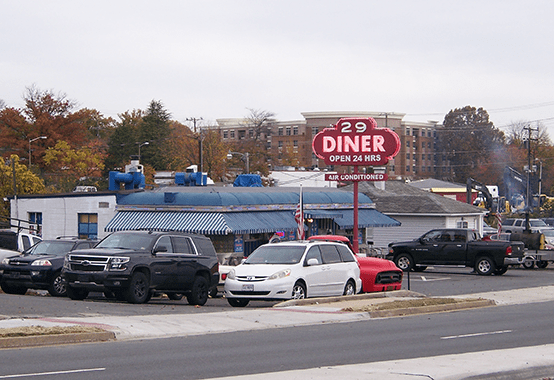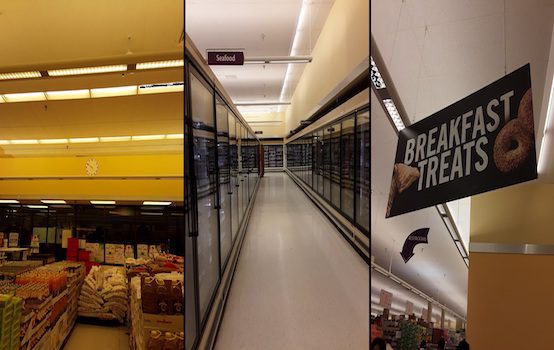Suburban Archaeology and America’s Architectural Commons

Suburban architecture, and the commercial highway strips that endlessly feature it, are rarely the subjects of praise. “Ticky-tacky,” “junkitecture,” and, of course, “geography of nowhere,” come to mind. The buildings that make up suburban sprawl are widely viewed as disposable, too cheaply and specifically built to lend themselves to adaptive reuse or to meld into an urban fabric.
This is broadly true, at least compared to the great organism-like cities with cohesive, tightly-knit, fine-grained built environments. But urbanism is not binary—it is reductive to categorize places as cities and “not cities,” urban and non-urban, “real places” and “placeless places.” This kind of thinking only obscures the continuum of urban features that exists everywhere. In this case, in particular, early commercial strips reveal far more dynamic activity and creative reuse than many might expect. (Whether the results are cohesive or aesthetically pleasing is a different question.) Case in point, what might be considered “bad” (and sometimes quite good) storefront conversion: the reuse of a very specific building, like a fast food outlet, for something else.

On any commercial strip older than about 20 years, most of the buildings have probably been something else, or were originally designed to be something else. A look through retail architecture Flickr accounts, historical Google Street View imagery, aerial photography archives, local internet message boards—and, of course, sites cataloging those storefront conversions—will reveal a surfeit of activity and change taking place even as the drab, generic appearance of these places remains.
Sometimes you will discover that demolition has gradually updated the appearance of these corridors. But in many cases, buildings that appear modern have been divided, added to, and renovated over the years. And in other cases, they have been reused with few alterations, their trademark features slowly melding into the broader built environment, transforming from brand identifiers to raw materials in the commercial churn. Consider that when a once-mighty chain shutters or slowly shrinks, its physical footprint almost always remains.
[googlemaps https://www.google.com/maps/embed?pb=!4v1551664084989!6m8!1m7!1sdwmawV7WFWxJUYt-AYEVqg!2m2!1d40.64475520833577!2d-75.34561442440966!3f337.9686795490821!4f-0.5530412089934913!5f3.325193203789971&w=600&h=450] A former Hollywood Video, with a portion of the sign reused
Once you begin to think of highway sprawl in terms of dynamic, layered commercial activity, you begin to notice clues and hints everywhere that point to a place’s past life. Uncovering the history of a building or commercial strip is like a mix of archaeology and detective work. The remnants of these old buildings are like fossils, revealing the geographic reach of shuttered chains, and the history of the buildings themselves. Sometimes, that history is preserved rather tackily, and is therefore easy to identify.
https://twitter.com/vinmromero/status/1045335840933785601
The iconic and once ubiquitous trapezoidal Pizza Hut is perhaps the most widely known example of this phenomenon; there is a whole blog dedicated just to buildings that “used to be a Pizza Hut.” But there are plenty of others, just in the realm of fast food: the Roy Rogers stone pillars; the Dairy Queen barn; the Arby’s 10-gallon hat sign; the occasional remnant of McDonald’s arches. If you know where and how to look, they are absolutely all over the place.
[googlemaps https://www.google.com/maps/embed?pb=!4v1551664009531!6m8!1m7!1s44kRn0HQykPfBa7JDurEVQ!2m2!1d42.2191446850447!2d-83.48944768287971!3f187.15578960001318!4f1.541706515737289!5f2.0740148542458736&w=600&h=450]Chinese restaurant in a former Howard Johnson’s, complete with repurposed cupola
Sometimes, you have to go inside. Near my parents’ house in New Jersey is a building split between a large liquor store and a discount produce market. A real retail architecture nerd might identify the facade as being from an old supermarket, but the main evidence is the retro A&P wood-paneled department signs inside the market. (They were even slightly updated by the owners.) Not far from my home in Virginia, along a commercial corridor in Herndon, a Korean supermarket took over an old Giant location, and left the signature Giant purple clock and some of the department signs.

Of course, a Dairy Queen barn or Pizza Hut trapezoid repurposed into a loan office or Peruvian chicken joint isn’t quite of the same historical significance as, say, the use of Roman ruins to build Renaissance churches. But the same principle of human activity is at work. As people come and go, and fortunes rise and fall, iconic and privatized or trademarked features—once Coliseum marble, today a Pizza Hut roof—lapse into a sort of architectural commons, a highway vernacular.
Why get a new sign when you have a perfectly good Arby’s cowboy hat out front? pic.twitter.com/IrX4gQ5ALF
— Paysoninho (@paysoninho) July 28, 2018
It is almost like the borrowing and tweaking of literary themes and characters before copyright. It produces a kind of architectural public domain, an overall style in which “types” are endlessly borrowed and repurposed. The dominance of national chains has not fundamentally altered this process, and in fact has energized it. When they close, most cannot be bothered to treat their distinctive architecture as though it were intellectual property, destroying it or rendering it unrecognizable; though McDonald’s, infamously defensive of its name and logo, does apparently tend to remove the most distinctive features on shuttered stores (but not every time).
As many of the conversions reveal, this tends to predominate in poorer areas and among more downmarket businesses. Most chains purchasing an existing building can afford to demolish it or revamp it to at least resemble their own trademark decor and architecture. Most small businesses in depressed neighborhoods cannot.
[googlemaps https://www.google.com/maps/embed?pb=!4v1551663575071!6m8!1m7!1s1oi322IPeXGc25wNvaCOSA!2m2!1d38.65710634025896!2d-77.25035834993854!3f124.51669977762636!4f-2.1163383879832054!5f2.0365016911646765&w=600&h=450] A vintage Roy Rogers restaurant building, with trademark stone pillars
This is probably one of the reasons why older commercial strips develop their distinctive tattered, slightly sketchy vibe. One can sense, even if not spotting every converted building, that there is something incongruous here; the secondhand use of mass-produced chain architecture wasn’t quite meant to be. That building wasn’t designed to be a loan and title office; this one wasn’t designed to be a pupuseria. Aging commercial strips are the architectural equivalent of thrift stores. Yet thriftiness and creative reuse were once universally understood to be virtues. We should value this, not sideline it.
[googlemaps https://www.google.com/maps/embed?pb=!4v1551663767988!6m8!1m7!1su1Zl50OJmptjgQuU18OyUQ!2m2!1d39.14104475850034!2d-77.2221066438876!3f161.79540167493394!4f-0.16674291711171918!5f2.2176467681910266&w=600&h=450] A former Roy Rogers building heavily renovated by McDonalds
As I wrote previously, in a piece on Google Maps and the built environment, “This all brings to mind an amusing formulation of Plutarch’s famous ‘Ship of Theseus’ thought experiment: if none of the original stores or landmarks remain along a highway, is it the same highway?” The answer, of course, is yes. Not only is it the same highway, this sort of ordered chaos is the very definition of a vibrant urbanized space.
Seriously studying the making and remaking of suburban places is in some ways like analyzing comic books or video games as art forms—suburbia is often viewed as being beneath such consideration. But the actual granular history of these places underscores that whatever its faults as a mode of development and way of life, suburbia is not all disposable ticky-tacky. It has its own culture, its own patterns, its own history.
In some ways, a repurposed McDonald’s or leftover supermarket signage is about as boring, mundane, and ultimately meaningless a thing as one can ponder. Yet it is also an immediate and highly visible example of vibrant, churning culture-making taking place right under our noses.
Addison Del Mastro is assistant editor of The American Conservative. He tweets at @ad_mastro.